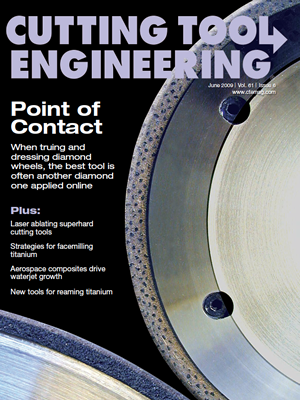To increase the productivity of a machine tool, the process must be repeatable. In addition, boosting machine tool productivity strongly depends on the dynamic characteristics of the machine. The stable spindle speeds and permissible chatter-free DOCs expressed in the stability diagram (see last month’s column) depend on the natural frequency, stiffness and damping of the entire machining assembly.
For most milling operations, the diagram reveals stable pockets, particular spindle speeds where substantially larger chatter-free DOCs are possible. The tool, toolholder, spindle, machine tool, workpiece and fixture all affect where the stable zones are. Once a process has been optimized using the stability diagram, changes in the setup are detrimental to performance. Yet, oddly, many of the tools and techniques available to machine tool users, such as tool length offset adjustment and post-processing of CNC programs, encourage nonrepeatable setups. So what items matter?
Let’s start with tool length. CNC machine tools allow users to approximately set tool length, measure that length and then enter a correction as an offset. If workpiece geometry were all that mattered, then that offset would work, but achieving high productivity depends on more than just workpiece geometry. If a user sets a tool longer than nominal, it is less stiff and has a lower natural frequency. In the stability diagram, the stable pockets then move to lower spindle speeds, and the chatter-free DOC is reduced. If the tool is set too short, it is stiffer and has a higher natural frequency. The stable pockets then move to higher spindle speeds. However, it is only possible to take advantage of the large axial DOC available in a stable pocket if the pocket does not move. To optimize productivity, end users must control tool length.
The number of tool teeth also impacts the location of stable spindle speeds. The most stable pocket occurs where a tooth’s passing frequency matches the natural frequency. Therefore, switching from a 2-flute to a 4-flute tool, for example, would decrease the spindle speed corresponding to the most stable pocket by 50 percent. Because staying in a stable pocket means tightly controlling the spindle speed, it also means avoiding use of the spindle speed override function. The appropriate spindle speed must be selected and programmed, and the spindle must run at the programmed speed.
The style of toolholder also matters. Collet-type, hydraulic, shrink-fit, Weldon and other holders all have different dynamic properties. It might be possible to adjust the part program to account for the geometric change caused by a new holder, but changing the holder means the stable spindle speeds move and the permissible chatter-free DOCs change.
Other repeatability items might be less obvious. For example, with a collet-type toolholder, the torque on the collet nut can affect repeatability. Most manufacturers of collet-type toolholders specify a torque on the nut, and that torque should be set using a torque wrench or torque-setting fixture. If the torque is too high, the holder’s stiffness could increase, but the damping would be lost. If the torque is low, the stiffness could be too low and—even worse—the tool might pull out of the holder. While on the topic of torque, for an ISO or CAT toolholder, the torque on the retention knob is critical and should also be set with a torque wrench. If it is too tight, it will cause the tail end of the toolholder to bulge, which changes the holder’s fit in the spindle taper and directly influences the stiffness and damping of the connection.
For ISO- and HSK-type connections, drawbar force matters. It might seem desirable to have the drawbar force as high as possible, but it isn’t. A high drawbar force does increase the stiffness of the connection, but it also eliminates damping. Machine tool builders specify an acceptable range, and it is a good idea to check the drawbar force with a drawbar dynamometer.
Because cutting performance is specific to the setup of the tool and its holder, among other items, you might suspect machine and spindle selection influences cutting performance. You’re right. Different machines perform differently, even with the same tooling. This means part programs should be written for a specific machine to take advantage of that machine’s stability diagram. The stability diagram for the same tool looks different on different machines.
NC programming software currently allows the part program to be written considering only workpiece geometry. The program is then post-processed to run on a variety of machines. This is a geometry-only strategy, and using it means a machine tool is underutilized and could benefit from significant improvements in productivity. CTE
About the Author: Dr. Scott Smith is a professor at the William States Lee College of Engineering, University of North Carolina at Charlotte, specializing in machine tool structural dynamics. Contact him via e-mail at [email protected].
Related Glossary Terms
- collet
collet
Flexible-sided device that secures a tool or workpiece. Similar in function to a chuck, but can accommodate only a narrow size range. Typically provides greater gripping force and precision than a chuck. See chuck.
- computer numerical control ( CNC)
computer numerical control ( CNC)
Microprocessor-based controller dedicated to a machine tool that permits the creation or modification of parts. Programmed numerical control activates the machine’s servos and spindle drives and controls the various machining operations. See DNC, direct numerical control; NC, numerical control.
- dynamometer
dynamometer
When drilling, a device for measuring the generated torque and axial force (thrust). When milling, a device for measuring the generated torque and feed force. When turning, a device for measuring the tangential, feed and radial forces.
- fixture
fixture
Device, often made in-house, that holds a specific workpiece. See jig; modular fixturing.
- gang cutting ( milling)
gang cutting ( milling)
Machining with several cutters mounted on a single arbor, generally for simultaneous cutting.
- milling
milling
Machining operation in which metal or other material is removed by applying power to a rotating cutter. In vertical milling, the cutting tool is mounted vertically on the spindle. In horizontal milling, the cutting tool is mounted horizontally, either directly on the spindle or on an arbor. Horizontal milling is further broken down into conventional milling, where the cutter rotates opposite the direction of feed, or “up” into the workpiece; and climb milling, where the cutter rotates in the direction of feed, or “down” into the workpiece. Milling operations include plane or surface milling, endmilling, facemilling, angle milling, form milling and profiling.
- numerical control ( NC)
numerical control ( NC)
Any controlled equipment that allows an operator to program its movement by entering a series of coded numbers and symbols. See CNC, computer numerical control; DNC, direct numerical control.
- stiffness
stiffness
1. Ability of a material or part to resist elastic deflection. 2. The rate of stress with respect to strain; the greater the stress required to produce a given strain, the stiffer the material is said to be. See dynamic stiffness; static stiffness.
- toolholder
toolholder
Secures a cutting tool during a machining operation. Basic types include block, cartridge, chuck, collet, fixed, modular, quick-change and rotating.


